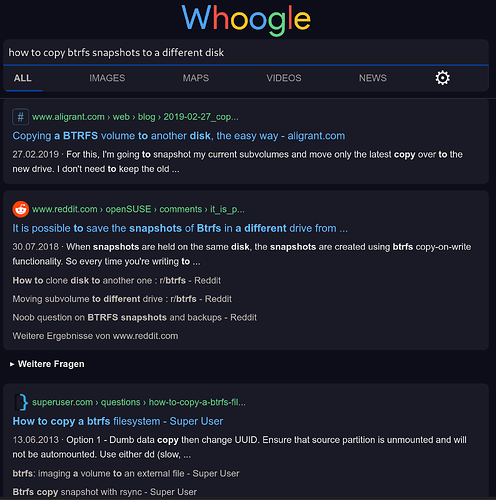I have snapshots stored at /.snapshots and at /home/.snapshots.
For the sake of backup, I want to copy them to a different disk.
What is the recommended way to do that?
garuda-inxi
System:
Kernel: 6.7.9-zen1-1-zen arch: x86_64 bits: 64 compiler: gcc v: 13.2.1
clocksource: tsc avail: hpet,acpi_pm
parameters: BOOT_IMAGE=/@/boot/vmlinuz-linux-zen
root=UUID=fb8e5411-1ae5-4076-a8b2-7e4927f1ae70 rw rootflags=subvol=@
quiet loglevel=3 ibt=off
Desktop: KDE Plasma v: 6.0.1 tk: Qt v: N/A info: frameworks v: 6.0.0
wm: kwin_wayland vt: 1 dm: SDDM Distro: Garuda base: Arch Linux
Machine:
Type: Desktop Mobo: ASUSTeK model: PRIME B365M-A v: Rev X.0x
serial: <superuser required> part-nu: SKU uuid: <superuser required>
UEFI: American Megatrends v: 2208 date: 07/09/2021
Battery:
ID-1: hidpp_battery_0 charge: 56% condition: N/A volts: 3.8 min: N/A
model: Logitech G903 LIGHTSPEED Wireless Gaming Mouse w/ HERO type: N/A
serial: <filter> status: discharging
CPU:
Info: model: Intel Core i7-9700 bits: 64 type: MCP arch: Coffee Lake
gen: core 9 level: v3 note: check built: 2018 process: Intel 14nm family: 6
model-id: 0x9E (158) stepping: 0xD (13) microcode: 0xFA
Topology: cpus: 1x cores: 8 smt: <unsupported> cache: L1: 512 KiB
desc: d-8x32 KiB; i-8x32 KiB L2: 2 MiB desc: 8x256 KiB L3: 12 MiB
desc: 1x12 MiB
Speed (MHz): avg: 4499 high: 4505 min/max: 800/4700 scaling:
driver: intel_pstate governor: performance cores: 1: 4499 2: 4500 3: 4500
4: 4505 5: 4499 6: 4499 7: 4497 8: 4497 bogomips: 48000
Flags: avx avx2 ht lm nx pae sse sse2 sse3 sse4_1 sse4_2 ssse3 vmx
Vulnerabilities: <filter>
Graphics:
Device-1: Intel CoffeeLake-S GT2 [UHD Graphics 630] vendor: ASUSTeK
driver: i915 v: kernel arch: Gen-9.5 process: Intel 14nm built: 2016-20
ports: active: HDMI-A-1,HDMI-A-2 empty: DP-1 bus-ID: 00:02.0
chip-ID: 8086:3e98 class-ID: 0300
Device-2: USB C Video Adaptor driver: N/A type: USB rev: 2.0
speed: 12 Mb/s lanes: 1 mode: 1.1 bus-ID: 1-3.1.1:8 chip-ID: 25a4:9321
class-ID: 1100 serial: <filter>
Device-3: Microdia USB Live camera driver: snd-usb-audio,uvcvideo
type: USB rev: 2.0 speed: 480 Mb/s lanes: 1 mode: 2.0 bus-ID: 1-3.4:7
chip-ID: 0c45:636b class-ID: 0102 serial: <filter>
Display: wayland server: X.org v: 1.21.1.11 with: Xwayland v: 23.2.4
compositor: kwin_wayland driver: X: loaded: modesetting
alternate: fbdev,intel,vesa dri: iris gpu: i915 display-ID: 0
Monitor-1: HDMI-A-1 model: VG27AQ1A serial: <filter> built: 2020
res: 2560x1440 dpi: 109 gamma: 1.2 size: 596x336mm (23.46x13.23")
diag: 685mm (27") ratio: 16:9 modes: max: 2560x1440 min: 720x400
Monitor-2: HDMI-A-2 model: Samsung S24B300 serial: <filter> built: 2013
res: 1920x1080 dpi: 94 gamma: 1.2 size: 521x293mm (20.51x11.54")
diag: 598mm (23.5") ratio: 16:9 modes: max: 1920x1080 min: 720x400
API: Vulkan v: 1.3.279 layers: 3 device: 0 type: integrated-gpu name: Intel
UHD Graphics 630 (CFL GT2) driver: mesa intel v: 24.0.2-arch1.2
device-ID: 8086:3e98 surfaces: xcb,xlib,wayland device: 1 type: cpu
name: llvmpipe (LLVM 17.0.6 256 bits) driver: mesa llvmpipe
v: 24.0.2-arch1.2 (LLVM 17.0.6) device-ID: 10005:0000
surfaces: xcb,xlib,wayland
API: EGL Message: EGL data requires eglinfo. Check --recommends.
Audio:
Device-1: Intel 200 Series PCH HD Audio vendor: ASUSTeK
driver: snd_hda_intel v: kernel alternate: snd_soc_avs bus-ID: 00:1f.3
chip-ID: 8086:a2f0 class-ID: 0403
Device-2: Microdia USB Live camera driver: snd-usb-audio,uvcvideo
type: USB rev: 2.0 speed: 480 Mb/s lanes: 1 mode: 2.0 bus-ID: 1-3.4:7
chip-ID: 0c45:636b class-ID: 0102 serial: <filter>
API: ALSA v: k6.7.9-zen1-1-zen status: kernel-api tools: N/A
Server-1: PipeWire v: 1.0.3 status: active with: 1: pipewire-pulse
status: active 2: wireplumber status: active 3: pipewire-alsa type: plugin
4: pw-jack type: plugin tools: pactl,pw-cat,pw-cli,wpctl
Network:
Device-1: Realtek RTL8111/8168/8211/8411 PCI Express Gigabit Ethernet
vendor: ASUSTeK PRIME B450M-A driver: r8169 v: kernel pcie: gen: 1
speed: 2.5 GT/s lanes: 1 port: e000 bus-ID: 03:00.0 chip-ID: 10ec:8168
class-ID: 0200
IF: enp3s0 state: up speed: 1000 Mbps duplex: full mac: <filter>
Device-2: Realtek RTL8153 Gigabit Ethernet Adapter driver: r8152 type: USB
rev: 3.0 speed: 5 Gb/s lanes: 1 mode: 3.2 gen-1x1 bus-ID: 2-3.1:7
chip-ID: 0bda:8153 class-ID: 0000 serial: <filter>
IF: enp0s20f0u3u1 state: down mac: <filter>
Info: services: NetworkManager, smbd, systemd-timesyncd
Bluetooth:
Device-1: Cambridge Silicon Radio Bluetooth Dongle (HCI mode) driver: btusb
v: 0.8 type: USB rev: 2.0 speed: 12 Mb/s lanes: 1 mode: 1.1 bus-ID: 1-9:6
chip-ID: 0a12:0001 class-ID: e001
Report: rfkill ID: hci0 rfk-id: 0 state: down bt-service: not found
rfk-block: hardware: no software: no address: see --recommends
Drives:
Local Storage: total: 2.26 TiB used: 1007.13 GiB (43.6%)
SMART Message: Required tool smartctl not installed. Check --recommends
ID-1: /dev/sda maj-min: 8:0 vendor: Kingston model: SA400S37480G
size: 447.13 GiB block-size: physical: 512 B logical: 512 B speed: 6.0 Gb/s
tech: SSD serial: <filter> fw-rev: K1B3 scheme: GPT
ID-2: /dev/sdb maj-min: 8:16 vendor: Toshiba model: HDWD120 size: 1.82 TiB
block-size: physical: 4096 B logical: 512 B speed: 6.0 Gb/s tech: HDD
rpm: 7200 serial: <filter> fw-rev: ACF0 scheme: GPT
Partition:
ID-1: / raw-size: 100.99 GiB size: 100.99 GiB (100.00%)
used: 12.33 GiB (12.2%) fs: btrfs dev: /dev/sda5 maj-min: 8:5
ID-2: /boot/efi raw-size: 100 MiB size: 96 MiB (96.00%)
used: 31 MiB (32.3%) fs: vfat dev: /dev/sda1 maj-min: 8:1
ID-3: /home raw-size: 100.99 GiB size: 100.99 GiB (100.00%)
used: 12.33 GiB (12.2%) fs: btrfs dev: /dev/sda5 maj-min: 8:5
ID-4: /var/log raw-size: 100.99 GiB size: 100.99 GiB (100.00%)
used: 12.33 GiB (12.2%) fs: btrfs dev: /dev/sda5 maj-min: 8:5
ID-5: /var/tmp raw-size: 100.99 GiB size: 100.99 GiB (100.00%)
used: 12.33 GiB (12.2%) fs: btrfs dev: /dev/sda5 maj-min: 8:5
Swap:
Kernel: swappiness: 133 (default 60) cache-pressure: 100 (default) zswap: no
ID-1: swap-1 type: zram size: 15.49 GiB used: 1.29 GiB (8.3%)
priority: 100 comp: zstd avail: lzo,lzo-rle,lz4,lz4hc,842 max-streams: 8
dev: /dev/zram0
Sensors:
System Temperatures: cpu: 37.0 C mobo: N/A
Fan Speeds (rpm): N/A
Info:
Memory: total: 16 GiB available: 15.49 GiB used: 8.23 GiB (53.1%)
Processes: 291 Power: uptime: 1h 26m states: freeze,mem,disk suspend: deep
avail: s2idle wakeups: 0 hibernate: platform avail: shutdown, reboot,
suspend, test_resume image: 6.18 GiB services: org_kde_powerdevil,upowerd
Init: systemd v: 255 default: graphical tool: systemctl
Packages: pm: pacman pkgs: 1302 libs: 396 tools: pamac Compilers:
gcc: 13.2.1 Shell: garuda-inxi default: Bash v: 5.2.26 running-in: konsole
inxi: 3.3.33
Garuda (2.6.23-1):
System install date: 2024-03-09
Last full system update: 2024-03-10 ↻
Is partially upgraded: No
Relevant software: snapper NetworkManager dracut
Windows dual boot: Probably (Run as root to verify)
Failed units:
